The global cardamom oil market is projected to grow from USD 205 million in 2025 to USD 309.3 million by 2035, registering a CAGR of 4.2%. Growth in the market is being driven by rising consumer inclination towards natural and organic ingredients across wellness, personal care, and food sectors.
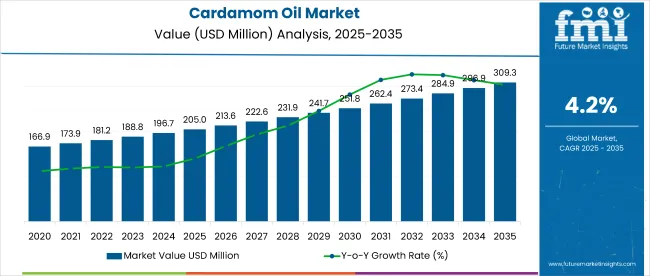
| Metric | Value |
|---|---|
| Industry Size (2025E) | USD 205 million |
| Industry Value (2035F) | USD 309.3 million |
| CAGR (2025 to 2035) | 4.2% |
Increasing awareness of cardamom oil’s therapeutic benefits, such as aiding digestion, reducing anxiety, and boosting immunity, is supporting its adoption in aromatherapy, nutraceuticals, and pharmaceutical formulations. Moreover, expanding demand for exotic flavors and essential oils in gourmet food and beverages continues to stimulate product uptake globally.
The market holds a modest yet strategic share across its parent markets. It accounts for 3% of the essential oils market and around 5% within the flavor and fragrance market. In the aromatherapy segment, it contributes about 6%, reflecting its rising use in wellness applications. Within the herbal extracts market, its share stands near 2.5%. In the broader nutraceutical ingredients and functional food markets, it holds a smaller presence at below 0.5%. In the natural cosmetics and personal care sector, cardamom oil represents around 1.5%, mainly due to its antimicrobial and aromatic properties.
Regulatory frameworks influencing the market emphasize purity, traceability, and safety of natural ingredients. The USA FDA’s GRAS (Generally Recognized As Safe) status for cardamom oil supports its use in food and dietary products. In Europe, REACH regulations and EFSA standards mandate transparency and safety for essential oil applications.
India’s FSSAI and AYUSH guidelines regulate its usage in traditional medicine and food products. These frameworks drive demand for standardized, steam-distilled cardamom oil with documented therapeutic properties and consistent quality, encouraging manufacturers to invest in certified production and sustainable sourcing practices.
Japan is projected to be the fastest-growing market, expected to expand at a CAGR of 5.0% from 2025 to 2035. The seeds segment will lead the source type category with a 70% share, while green cardamom will dominate the source segment with a 62% share. The USA and UK markets are expected to grow steadily at CAGRs of 4.5% and 4.3%, respectively. Germany and France are projected to expand at 4.6% and 4.4% CAGRs, respectively.
The global market is segmented by source, source type, distribution channel, industry application, and region. By source, the market is divided into green cardamom (small cardamom) and black cardamom (large cardamom). Based on source type, the market includes outer shell or pod and seeds. In terms of distribution channel, the market is categorized into B2B, B2C, supermarket/hypermarket, departmental store, convenience store, online retail, and others (specialty health stores, wellness spas, ayurvediccenters, and export trading companies).
By application, the market is segmented into health & wellness, home, personal care industry, pharmaceutical industry, food & beverages, automotive industry, and others (fragrance manufacturing, spa therapy, nutraceutical blends, and herbal insect repellents). Regionally, the market is classified into North America, Latin America, Western Europe, Eastern Europe, Asia Pacific, and the Middle East & Africa.
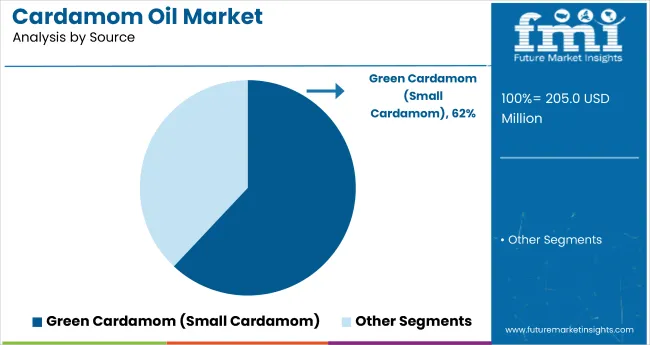
Green cardamom is projected to lead the source segment with a 62% market share in 2025. Its dominance is driven by strong aroma, rich oil content, and versatile use across culinary, wellness, and therapeutic applications, making it the preferred choice for essential oil extraction and high-value natural formulations.
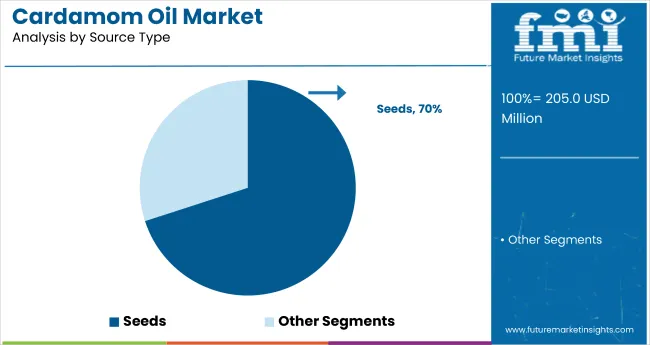
Cardamom seeds are projected to dominate the source type segment with a 70% market share in 2025, driven by their high essential oil concentration and superior extraction yield. Their strong aroma and purity make them the preferred choice for use in food, personal care, and pharmaceutical formulations.
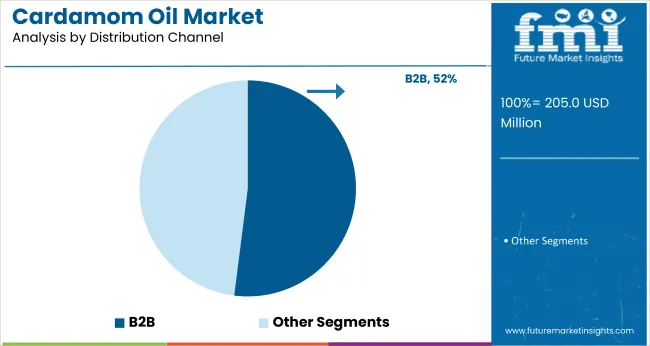
The B2B channel is projected to lead the distribution segment with a 52% market share in 2025. This growth is supported by strong demand from food processors, essential oil manufacturers, and cosmetic companies seeking bulk procurement of high-quality, natural cardamom oil for commercial applications.
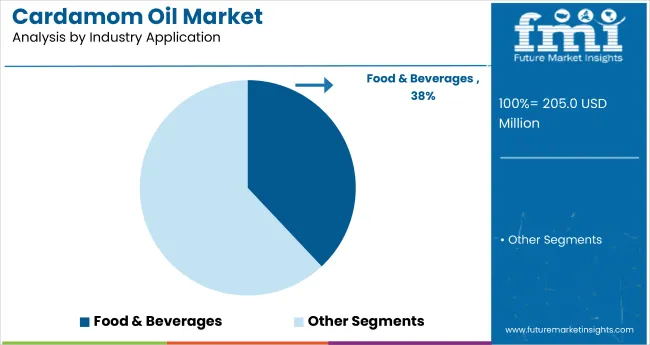
The food & beverages segment is projected to hold a 38% share of the global market in 2025, driven by the growing use of cardamom oil as a natural flavoring in teas, bakery products, and traditional cuisines. Rising demand for clean-label ingredients is further boosting its adoption in this segment.
The global cardamom oil market is experiencing steady growth, driven by increasing consumer preference for natural and organic products across food, wellness, and personal care industries. Cardamom oil’s therapeutic properties and aromatic profile make it a valuable ingredient in various high-growth applications.
Recent Trends in the Cardamom Oil Market
Challenges in the Cardamom Oil Market

Japan momentum is supported by demand in wellness and traditional medicine, combined with clean-label preferences and product innovations in aromatherapy and herbal remedies. Germany and France continue to maintain strong demand due to expanding personal care and organic food sectors, supported by EU regulations on natural additives. Developed economies such as the USA (4.5% CAGR), UK (4.3%), and Japan (5.0%) are expected to growat a steady 1.02-1.19x of the global growth rate.
Japan shows the fastest growth in the cardamom oil market, supported by rising demand for wellness products, functional foods, and aromatherapy. The USA follows, with strong interest from clean-label beverage makers and essential oil retailers. Germany benefits from increasing adoption of natural ingredients in food and cosmetics, driven by regulatory alignment and consumer trust.
France is expanding steadily, supported by demand in skincare, herbal teas, and premium personal care. The UK maintains stable growth, driven by functional tea blends and personal hygiene products. All five markets are advancing above the global average, driven by a shift toward natural and certified formulations.
The report covers in-depth analysis of 40+ countries; five top-performing OECD countries are highlighted below.
The Japan cardamom oil market is growing at a CAGR of 5.0% from 2025 to 2035. Demand is driven by natural wellness products, herbal medicine, and functional aromatherapy. Japan consumers value purity, traceability, and therapeutic effects, making steam-distilled and certified oils more preferred. Cardamom oil is increasingly used in digestive remedies and relaxation formulas.
The Germany cardamom oil market is expected to expandat a CAGR of 4.6%, slightly above the global average. Growth is supported by the rise of organic food products, clean-label seasonings, and demand for natural fragrance ingredients in cosmetics. Germany places strong emphasis on regulatory compliance, especially for essential oil safety and labeling.
The France cardamom oil market is projected to grow at a 4.4% CAGR through 2035, driven by increasing demand in the beauty and health sectors. Cardamom oil is favored in niche skincare, luxury personal care, and herbal teas. France benefits from strong consumer awareness of botanical ingredients and rising exports of premium essential oils.
The USA cardamom oil market is projected to grow at a CAGR of 4.5% from 2025 to 2035, reflecting stable interest in natural health and culinary applications. Demand is driven by wellness retailers, clean-label beverages, and growing aromatherapy use among consumers. The USA market favors high-purity and organic-certified oils, particularly in the food and personal care industries.
The UK cardamom oil market is expected to expand at a CAGR of 4.3% from 2025 to 2035, slightly above the global rate. Growth is supported by increased use of cardamom oil in functional teas, ethnic cuisine, and personal hygiene products. The UK market favors flexible use products for health-conscious consumers.
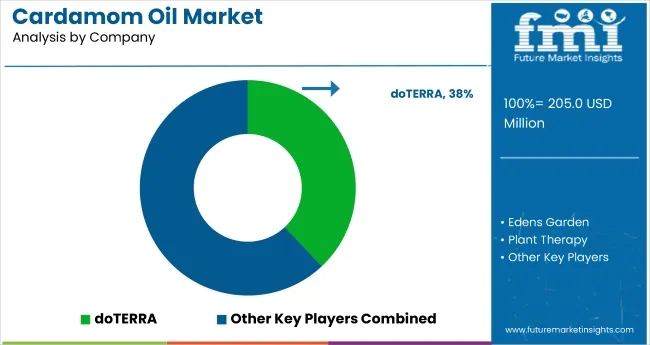
The cardamom oil market is moderately fragmented, with key players such as Essential Oils Company, doTERRA, Edens Garden, Miracle Botanicals, and Aura Cacia leading the supply landscape. These companies focus on producing high-purity, steam-distilled cardamom oil for applications across food, wellness, and personal care sectors.
Essential Oils Company emphasizes bulk supply and global sourcing, while doTERRA is recognized for its certified therapeutic-grade oils with a focus on wellness and sustainability. Edens Garden and Miracle Botanicals specialize in artisanal and small-batch production for aromatherapy use. Aura Cacia and Simply Earth offer affordable, ethically sourced oils targeting mainstream retail and DIY consumers.
Other notable brands like Plant Therapy, Piping Rock, Healing Solutions, Timpanogos Essentials, and Aromatics International cater to niche segments, offering USDA-certified organic products and targeted wellness blends for digestive support, stress relief, and natural skincare formulations.
Recent Cardamom Oil Industry News
| Report Attributes | Details |
|---|---|
| Market Size (2025) | USD 205 million |
| Projected Market Size (2035) | USD 309.3 million |
| CAGR (2025 to 2035) | 4.2% |
| Base Year for Estimation | 2024 |
| Historical Period | 2020 to 2024 |
| Projections Period | 2025 to 2035 |
| Report Parameter | USD million for value/Volume in Metric Tons |
| Source Analyzed | Green Cardamom (Small Cardamom), Black Cardamom (Large Cardamom) |
| Source Type Analyzed | Outer Shell or Pod, Seeds |
| Distribution Channel Analyzed | B2B, B2C, Supermarket/Hypermarket, Departmental Store, Convenience Store, Online Retail, Others (specialty health stores, wellness spas, Ayurvedic centers , and export trading companies). |
| Industry Application Analyzed | Health and Wellness, Home, Personal Care Industry, Pharmaceutical Industry, Food and Beverages, Automotive Industry, Others (fragrance manufacturing, spa therapy, nutraceutical blends, and herbal insect repellents) |
| Regions Covered | North America, Latin America, Western Europe, South Asia, East Asia, Eastern Europe, Middle East & Africa |
| Countries Covered | United States, United Kingdom, Germany, France, Japan, China, India, Brazil, South Korea, Australia and 40+ countries |
| Key Players Influencing the Market | Essential Oils Company, doTERRA , Edens Garden, Miracle Botanicals, Aura Cacia, Simply Earth, Plant Therapy, Piping Rock, Healing Solutions, Timpanogos Essentials, Aromatics International |
| Additional Attributes | Dollar sales by application, share by source, regional demand trends, policy influence, wellness and organic certification impact, competitive benchmarking |
The global cardamom oil market is estimated to be valued at USD 205.0 million in 2025.
The market size for the cardamom oil market is projected to reach USD 309.3 million by 2035.
The cardamom oil market is expected to grow at a 4.2% CAGR between 2025 and 2035.
The key product types in cardamom oil market are green cardamom (small cardamom) and black cardamom (large cardamom).
In terms of source type, outer shell or pod segment to command 57.6% share in the cardamom oil market in 2025.






Our Research Products

The "Full Research Suite" delivers actionable market intel, deep dives on markets or technologies, so clients act faster, cut risk, and unlock growth.

The Leaderboard benchmarks and ranks top vendors, classifying them as Established Leaders, Leading Challengers, or Disruptors & Challengers.

Locates where complements amplify value and substitutes erode it, forecasting net impact by horizon

We deliver granular, decision-grade intel: market sizing, 5-year forecasts, pricing, adoption, usage, revenue, and operational KPIs—plus competitor tracking, regulation, and value chains—across 60 countries broadly.

Spot the shifts before they hit your P&L. We track inflection points, adoption curves, pricing moves, and ecosystem plays to show where demand is heading, why it is changing, and what to do next across high-growth markets and disruptive tech

Real-time reads of user behavior. We track shifting priorities, perceptions of today’s and next-gen services, and provider experience, then pace how fast tech moves from trial to adoption, blending buyer, consumer, and channel inputs with social signals (#WhySwitch, #UX).

Partner with our analyst team to build a custom report designed around your business priorities. From analysing market trends to assessing competitors or crafting bespoke datasets, we tailor insights to your needs.
Supplier Intelligence
Discovery & Profiling
Capacity & Footprint
Performance & Risk
Compliance & Governance
Commercial Readiness
Who Supplies Whom
Scorecards & Shortlists
Playbooks & Docs
Category Intelligence
Definition & Scope
Demand & Use Cases
Cost Drivers
Market Structure
Supply Chain Map
Trade & Policy
Operating Norms
Deliverables
Buyer Intelligence
Account Basics
Spend & Scope
Procurement Model
Vendor Requirements
Terms & Policies
Entry Strategy
Pain Points & Triggers
Outputs
Pricing Analysis
Benchmarks
Trends
Should-Cost
Indexation
Landed Cost
Commercial Terms
Deliverables
Brand Analysis
Positioning & Value Prop
Share & Presence
Customer Evidence
Go-to-Market
Digital & Reputation
Compliance & Trust
KPIs & Gaps
Outputs
Full Research Suite comprises of:
Market outlook & trends analysis
Interviews & case studies
Strategic recommendations
Vendor profiles & capabilities analysis
5-year forecasts
8 regions and 60+ country-level data splits
Market segment data splits
12 months of continuous data updates
DELIVERED AS:
PDF EXCEL ONLINE
Oily Waste Can Market Size and Share Forecast Outlook 2025 to 2035
Oil and Gas Seal Market Size and Share Forecast Outlook 2025 to 2035
Oil Coalescing Filter Market Size and Share Forecast Outlook 2025 to 2035
Oil-immersed Iron Core Series Reactor Market Size and Share Forecast Outlook 2025 to 2035
Oil and Gas Sensor Market Forecast Outlook 2025 to 2035
Oil Packing Machine Market Forecast and Outlook 2025 to 2035
Oil and Gas Pipeline Coating Market Forecast and Outlook 2025 to 2035
Oilfield Scale Inhibitor Market Size and Share Forecast Outlook 2025 to 2035
Oil-in-Water Anionic Emulsifier Market Size and Share Forecast Outlook 2025 to 2035
Oil and Gas Field Services Market Size and Share Forecast Outlook 2025 to 2035
Oil Control Shampoo Market Size and Share Forecast Outlook 2025 to 2035
Oil Expellers Market Size and Share Forecast Outlook 2025 to 2035
Oilfield Stimulation Chemicals Market Size and Share Forecast Outlook 2025 to 2035
Oiler Kits Market Size and Share Forecast Outlook 2025 to 2035
Oil Pressure Sensor Market Size and Share Forecast Outlook 2025 to 2035
Oil Filled Power Transformer Market Size and Share Forecast Outlook 2025 to 2035
Oily Skin Control Products Market Analysis - Size and Share Forecast Outlook 2025 to 2035
Oil Immersed Shunt Reactor Market Size and Share Forecast Outlook 2025 to 2035
Oil Country Tubular Goods Market Size and Share Forecast Outlook 2025 to 2035
Oil Filled Distribution Transformer Market Size and Share Forecast Outlook 2025 to 2035

Thank you!
You will receive an email from our Business Development Manager. Please be sure to check your SPAM/JUNK folder too.
Chat With
MaRIA